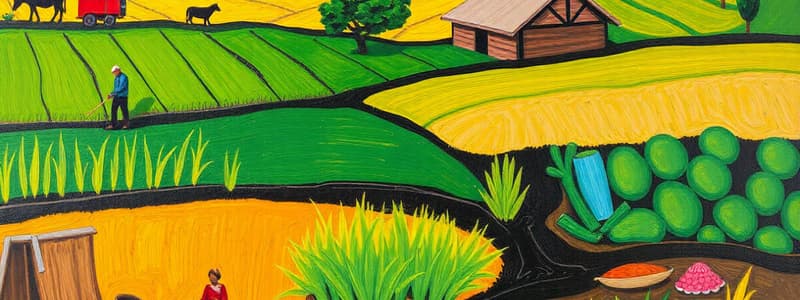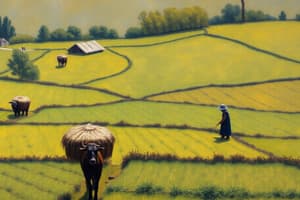Podcast
Questions and Answers
What types of crops does Munna Lal typically grow on his farm?
What types of crops does Munna Lal typically grow on his farm?
- Fruits and vegetables
- Corn and soybeans
- Wheat or rice and pulses (correct)
- Only rice
Munna Lal uses a traditional method of ploughing his field with bullocks.
Munna Lal uses a traditional method of ploughing his field with bullocks.
False (B)
How large is Munna Lal's farmland?
How large is Munna Lal's farmland?
1.5 hectares
Munna Lal typically takes advice from friends, elders, and __________ regarding farming practices.
Munna Lal typically takes advice from friends, elders, and __________ regarding farming practices.
Match the following farming practices with their descriptions:
Match the following farming practices with their descriptions:
What is agriculture commonly referred to as?
What is agriculture commonly referred to as?
Horticulture refers to the breeding of fish in specially constructed tanks and ponds.
Horticulture refers to the breeding of fish in specially constructed tanks and ponds.
What does sericulture involve?
What does sericulture involve?
_________ involves the cultivation of grapes.
_________ involves the cultivation of grapes.
Match the following agricultural activities with their definitions:
Match the following agricultural activities with their definitions:
Flashcards are hidden until you start studying
Study Notes
Munna Lal's Farming Practices
- Munna Lal employs traditional agricultural techniques, notably using bullocks for ploughing, which has been a common practice in rural farming communities for generations. This method not only respects historical practices but also promotes sustainable farming by utilizing animal power instead of machinery. The use of bullocks allows for greater soil aeration and ensures that the soil structure remains intact, aiding in the overall health of the ecosystem.
- As a proactive farmer, Munna Lal values the input of numerous resources for guidance. He frequently seeks advice from his peers, older generations who possess invaluable experience, and formal agricultural experts. This network of support enables him to stay informed about the latest farming advancements, pest control methods, soil management techniques, and crop rotation practices, which all contribute to increased yield and sustainability in his farming operations.
Types of Agriculture
- Agriculture is commonly referred to as farming, which encompasses various methods, practices, and techniques aimed at cultivating crops and raising livestock for food production and other economic activities. It forms the backbone of rural economies and is essential for food security worldwide.
- Horticulture refers to the specialized branch of agriculture focused on the cultivation of fruits, vegetables, nuts, seeds, herbs, sprouts, mushrooms, algae, flowers, seaweeds, and non-food crops such as grass and ornamental trees and plants. It's crucial to note that horticulture is not the breeding of fish in specially constructed tanks and ponds; that practice falls under pisciculture, which is distinctly different.
- Sericulture involves a highly specialized process where silkworms are cultivated for the production of silk. This ancient practice is integral to the textile industry and requires a thorough knowledge of silkworm biology, breeding, and care. The silk produced is not only essential for clothing but also contributes to the economy through trade.
- Viticulture is the branch of horticulture concerned with the cultivation of grapevines, primarily for winemaking. This practice requires distinct climate conditions, soil types, and meticulous vineyard management to produce high-quality grapes, which are essential for various wine types and styles.
Agricultural Activities
- Agriculture is an intricate field that combines both science and art. It encompasses the systematic study of cultivating plants and animals and involves a deep understanding of biological, environmental, and technological factors that influence growth, health, and productivity.
- Horticulture not only fulfills personal and community needs for produce but also plays a significant role in landscaping and enhancing the beauty of spaces. It's a vital aspect of food production and provides nutritional benefits through the cultivation of various edible plants.
- Pisciculture refers to the practice of breeding fish in specially constructed facilities, such as aquaculture farms or ponds. This form of agriculture is crucial for meeting the growing demand for fish and helps alleviate pressure on wild fish populations, supporting sustainable seafood production.
- Apiculture, or beekeeping, is essential for pollination, which contributes significantly to agricultural productivity. Beekeeping not only allows for the harvesting of honey and other bee products like beeswax but also supports biodiversity and the health of ecosystems.
- Sericulture plays a fundamental role in the textile industry and supports a variety of livelihoods through silk production. It requires careful management of silkworm rearing, along with an understanding of environmental factors that can influence silk yields.
- Viticulture involves not just the growing of grapes but also the entire process of vineyard management, which can include soil preparation, irrigation, and pest control, leading to successful vinification and high-quality wine production.
Studying That Suits You
Use AI to generate personalized quizzes and flashcards to suit your learning preferences.




